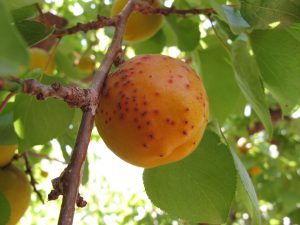Click Here to view the pdf version.
News/ What to Watch For:
Spider mites will continue to be active through the end of the month, and then will begin migrating to ground cover for overwintering
Protect peaches from late season coryneum blight infection (shown at right) if rain is predicted.
- Backyard growers, apply fungicide before rain; use Captan or Spectracide Immunox
Continue to carefully irrigate trees through the next several weeks
JUST THE BASICS
APPLE AND PEAR
- Continue protecting fruit from codling moth through Sept. 15
PEACH/NECTARINE
- Continue protecting fruit from peach twig borer through Sept. 15
- Continue protecting lower trunk from greater peach twig borer though early October[/mks_one_half]
WALNUT
- Continue protecting walnuts from walnut husk fly until one month before harvest
Backyard Grower Information
APPLE/PEAR
Codling Moth
Hosts: apple/pear
We are still trapping codling moth, and in some areas, weekly catches are high. The recommended time to stop treatments is September 15. The reason for this arbitrary timing is that codling moth can “sense” shorter day lenght. They are naturally “forced” into a resting stage called diapause starting in late August, and by mid-September, much of codling moth activity has ceased. You might consider one last treatment to maintain protection for these last 3 weeks.
PEACH/NECTARINE
Pests of Ripening Fruit
Hosts: peach/nectarine
Many peach varieties are being harvested now, which means that pests are attracted to ripening fruit are becoming more apparent, including boxelder bugs, earwigs, European paper wasps, and sap beetles. One of the best tools for managing these pests is to harvest fruit quickly as it ripens, or even just before fully ripe. Keep an eye on the ripest peaches on the trees to see if any of these pests are present.
Boxelder Bugs
Boxelder bugs feed with piercing-sucking mouthparts, and can cause fruit flesh to dry out or can introduce decay bacteria or fungi.
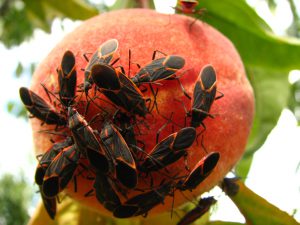
Earwigs
Earwigs are a perennial problem in ripening peaches, as they are concentrated in irrigated areas. Once the fruit softens, they will enter not only through existing openings, but will chew their own holes, leaving deep pits. Earwig damage is usually easy to diagnose because they leave behind black dots of excrement on the fruit surface.
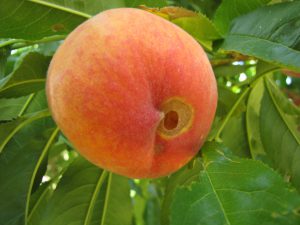
Controlling adults can be difficult due to their limited exposure to surface-applied insecticides. Carbaryl (Sevin) or Spinosad have both shown good control for earwigs. Either product should be applied just before the peach fruits start to soften.
European Paper Wasp
Wasps usually seek out fruit that is already damaged, and suck out juices. To deal with European paper wasps, make a homemade trap by cutting the top third from a plastic soda bottle and inverting it into the bottom portion. Punch a hole on each side and tie on string for hanging. Add a mixture of 1 part fruit juice 10 parts water plus 1 tsp liquid detergent to keep the wasps in the water. Adding a bit of ripened fruit will make it even more attractive.
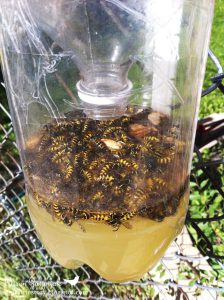
Sap Beetles
Sap beetles are opportunistic insects that can enter peaches through tiny openings, primarily caused by split pits or soft sutures. The smallest openings (which would occur at the stem end in the case of split pits) or overripe fruit are all the invitation that is needed. When the fruit is handled, the beetles will scurry out.
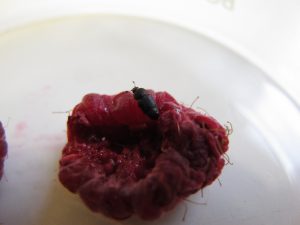
As these insects travel in and out of fruit, they introduce fungi into the fruit, causing it to decay.
Treatment Options for Pests of Ripening Peaches
The best control measure for pests of ripening fruit is good sanitation. Any damaged, splitting, or overripe fruit should be pulled from the tree and dropped to the ground immediately to encourage decomposition.
If there is a problem with large numbers of any of these pests during harvest, there are two insecticide options. Both options require contact with the target pest.
- pyrethrin (Prentox Pyronyl Crop Spray, Pyrellin, Pyganic, Fertilome Fruit Tree Spray, Natural Guard Neem Spray, etc.): 0-day PHI
- Sevin, 3-day PHI
Precautionary Statement: Utah State University Extension and its employees are not responsible for the use, misuse, or damage caused by application or misapplication of products or information mentioned in this document. All pesticides are labeled with ingredients, instructions, and risks. The pesticide applicator is legally responsible for proper use. USU makes no endorsement of the products listed herein.
Utah State University is an affirmative action/equal opportunity institution.

